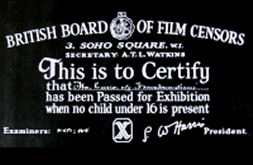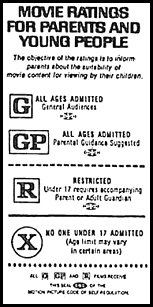


|
 |
|
 |
The
British Board of Film Censors,
as it was known in the Sixties, was set up and empowered to vet films to ensure that they didn't contain unsuitable material for public viewing and, where passed, to classify them into various categories providing the cinema-goer with a guide as to what should be suitable for various different age groups. Probably the most memorable screen signature in the Sixties was 'Harlech' - Lord Harlech who headed the organisation from 1965, dying in a car crash in 1985. Classifications in use in the Sixties were U, A and X but lots of others have also been used through the evolution of censorship since the system was originally introduced in 1912, such as 'H' for 'horrific'.. The British Board of Film Censorship was established in 1912 under the guardianship of the Incorporated Association of Kinematograph Manufacturers, the film trade associations who preferred to manage their own censorship rather than have national or local government do it for them. The push for the board's formation was fuelled by the controversy surrounding the release in the UK in October 1912 of the film 'From the Manger to the Cross', about the life of Jesus and resulted in its |
|
The BBFC’s title was changed to the British Board of Film Classification in 1984 and the chronological list below gives all the official BBFC classifications ever used: |
|
|
U
|
(Universal) 1912 to present. Films suitable for everyone. |
|
A
|
(Adult) 1912 to 1982. Films which might contain material unsuitable for 'children'. From 1923 to 1970 children had to be accompanied by an adult. The A rating was superseded by the PG certificate in 1982. |
|
H
|
(Horrific) 1932 to 1951. A strange rating that was almost entirely restricted to that genre of film. It was purely advisory, but was used by many local authorities to restrict viewing to 16s or over. |
|
X
|
This replaced the H certificate in 1951 and was the first BBFC rating that specifically excluded people under the age of 16. This age restriction was raised to 18 in 1970. |
|
AA
|
This new rating was introduced in 1970, when the X rating was raised to 18, in order to provide an intermediate age rating by excluding people under the age of 14. This was replaced by the more specific 15 rating in 1982. |
|
PG
|
(Parental Guidance) This was introduced in the sweeping changes of 1982,
replacing the old A certificate. Although anyone could actually be admitted, PG-rated films contained an explicit warning that the film might contain material unsuitable for viewing by younger children. |
|
15
|
This replaced the AA certificate in 1982 when raising the age limit to 15. |
|
18
|
This replaced the X certificate in 1982, more specifically excluding people under the age of 18. |
|
R18
|
This classification, introduced in 1982, was exclusively intended for videos that could only be shown in licensed cinemas or sold in adult sex shops. |
|
Uc
|
Introduced in 1985, this rating indicates video releases which are deemed particularly suitable for pre-school children. This certificate was retired in 2009. (video only) |
|
12
|
This was introduced for cinema films in 1989 (and also video releases from 1994), stating that, while the film contained material deemed unsuitable for young children, were considered appropriate for 12s and upwards. |
|
PG-12
|
Suitable for those aged 12 and older (cinema only); under 12s admitted, but only if accompanied by an adult. This experimental certificate was used during a short BBFC trial in Norwich from October 2001 to January 2002, in which all 12 certificate films on release were classed as PG-12. The results of the trial led to the adoption of the 12A later in 2002 |
|
12A
|
This was introduced for cinema films in 2002, replacing the 12 and PG-12 certificates, allowing under 12s to watch the films if they were accompanied by a responsible adult. |
| The MPPDA
(Motion Picture Producers and Distributors of America) organisation was
administrating film Production Code by the 1940s, becoming known as the
Motion Picture Association of America (MPAA). The Production Code Administration
(and the Motion Picture Production Code - known as the 'Hays Code' after
its creator Will H.Hays), that had been established in the early 1930s,
was effectively finished by 1966 from pressures rising against the old-fashioned
censorship body. New president Jack Valenti was appointed in 1966 and abolished the Hays Code in 1967. In November 1968 a major revision replaced the outdated and unnecessarily restrictive code, promoting greater artistic freedom without the threat of censorship by the government and allowing Hollywood to compete against the more adult-targeted foreign productions. There was considerably less restraint on sex, violence, nudity and obscenity when the new voluntary ratings code was announced. It was to be overseen by the Motion Picture Association of America (MPAA) under the Classification and Rating Administration and the new ratings were to be enforced by theatres, exhibitors and distributors. The four new ratings introduced were: 'G' (general audiences - suitable for all ages), 'M' (mature audiences), 'R' (restricted audiences - no one under the age of 16 admitted without an accompanying adult) and 'X' (for 16 years and older). In1969 the 'M' rating was changed to 'GP' (general patronage) and, in 1970, to 'PG' (parental guidance suggested) with the age restriction raised from 16 to 17. This new system offered mainly advisory classification to exclude under-17s from 'X'-rated films as opposed to an outright restriction and placed films in categories according to appropriateness for younger viewers. Other than the Disney organisation, many film makers tried to avoid getting a 'G' rating, thereby increasing their attraction for more adult audiences. Many foreign film makers didn't even bother to submit their films to the ratings board due to lack of wide appeal and only got shown in 'arthouse' establishments. The first films to be rated 'M' with the new system were 'Who's Afraid of Virginia Woolf?' (1966) with its explicit four-letter dialogue and the sexually risque British film 'Alfie' (1966). |
 |
|
|
All
Original Material Copyright SixtiesCity
Other individual owner copyrights may apply to Photographic Images |